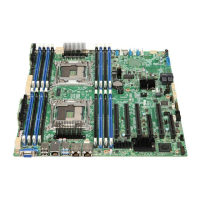Intel® Server Board S2600CW Functional Architecture Intel® Server Board S2600CW Family TPS
22 Revision 2.4
I/O device assignment: for flexibly assigning I/O devices to VMs and extending the
protection and isolation properties of VMs for I/O operations.
DMA remapping: for supporting address translations for Direct Memory Accesses
(DMA) from devices.
Interrupt remapping: for supporting isolation and routing of interrupts from devices
and external interrupt controllers to appropriate VMs.
Interrupt posting: for supporting direct delivery of virtual interrupts from devices and
external interrupt controllers to virtual processors.
Reliability: for recording and reporting of DMA and interrupt errors to system software
that may otherwise corrupt memory or impact VM isolation.
Intel® VT-d specifications and functional descriptions are included in the Intel® Virtualization
Technology for Directed I/O application documents.
3.2.3 Intel® Trusted Execution Technology for Servers (Intel® TXT)
Intel® TXT defines platform-level enhancements that provide the building blocks for creating
trusted platforms. The Intel® TXT platform helps to provide the authenticity of the controlling
environment so that those wishing to rely on the platform can make an appropriate trust
decision. The Intel® TXT platform determines the identity of the controlling environment by
accurately measuring and verifying the controlling software.
3.2.4 Execute Disable
Intel's Execute Disable Bit functionality can help prevent certain classes of malicious buffer
overflow attacks when combined with a supporting operating system. This allows the
processor to classify areas in memory by where application code can execute and where it
cannot. When a malicious worm attempts to insert code in the buffer, the processor disables
code execution, preventing damage and worm propagation.
3.2.5 Advanced Encryption Standard (AES)
These instructions enable fast and secure data encryption and decryption, using the Advanced
Encryption Standard (AES).
3.2.6 Intel® Hyper-Threading Technology
The processor supports Intel® Hyper-Threading Technology (Intel® HT Technology), which
allows an execution core to function as two logical processors. While some execution
resources such as caches, execution units, and buses are shared, each logical processor has its
own architectural state with its own set of general-purpose registers and control registers.
This feature must be enabled via the BIOS and requires operating system support.
3.2.7 Intel® Turbo Boost Technology
Intel® Turbo Boost Technology is a feature that allows the processor to opportunistically and
automatically run faster than its rated operating frequency if it is operating below power,
temperature, and current limits. The result is increased performance in multi-threaded and

